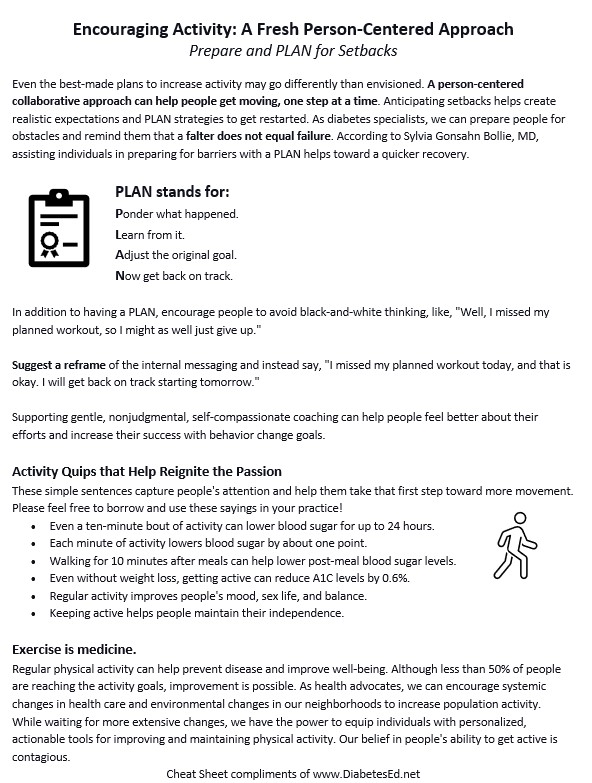
With summer in the air, it’s a perfect time to take a fresh approach to explore what activities people enjoy most and help them take that first step forward!
The majority of people with diabetes are aware that regular activity is integral to diabetes self-care and helps lower blood sugars for 24 -48 hours. However, getting started and maintaining momentum can be tough. With thoughtful coaching, we can support them to make progress toward the target of 150 minutes of walking (or other activity) a week coupled with strength training.
Coach Beverly has outlined five strategies that she has found helpful in encouraging people to move more.
Everything off the Couch Counts
Getting started with regular activity can seem daunting for many people. We can help lift that fear by encouraging them to start with baby steps and substitute the term “activity” for “exercise”. Reassuring people that “any movement is better than no movement” allows them to shift their perspective and give themselves credit for something as simple as walking to the mailbox.
The goal is to accumulate about thirty minutes of activity a day, so taking a 10-minute walk after breakfast means they are one-third of the way there. Other activities that count include; gardening, housework, yard work, shopping, chasing kids, and those dance moves people do when no one is looking.
Preparing for Set-Backs
Even the best-made plans to increase activity may go differently than envisioned. A person-centered collaborative approach can help people get moving, one step at a time. Anticipating setbacks helps create realistic expectations and PLAN strategies to get restarted. As diabetes specialists, we can prepare people for obstacles and remind them that a falter does not equal failure. According to Sylvia Gonsahn Bollie, MD, assisting individuals in preparing for barriers with a PLAN helps toward a quicker recovery.
PLAN stands for:
 – Ponder what happened.
– Ponder what happened.
– Learn from it.
– Adjust the original goal.
– Now get back on track.
In addition to having a PLAN, encourage people to avoid black-and-white thinking, like, “Well, I missed my planned workout, so I might as well just give up.”
Suggest a reframe of the internal messaging and instead say, “I missed my planned workout today, and that is okay. I will get back on track starting tomorrow.”
Supporting gentle, nonjudgmental, self-compassionate coaching can help people feel better about their efforts and increase their success with behavior change goals.
Activity Quips that Help Reignite the Passion
These simple sentences capture people’s attention and help them take that first step toward more movement. Please feel free to borrow and use these sayings in your practice!
- Even a ten-minute bout of activity can lower blood sugar for up to 24 hours.
- Each minute of activity lowers blood sugar by about one point.
 Walking for 10 minutes after meals can help lower post-meal blood sugar levels.
Walking for 10 minutes after meals can help lower post-meal blood sugar levels.- Even without weight loss, getting active can reduce A1C levels by 0.6%.
- Regular activity improves people’s mood, sex life, and balance.
- Keeping active helps people maintain their independence.
Exercise is medicine.
Regular physical activity can help prevent disease and improve well-being. Although less than 50% of people are reaching the activity goals, improvement is possible. As health advocates, we can encourage systemic changes in health care and environmental changes in our neighborhoods to increase population activity.
Cheat Sheet compliments of www.DiabetesEd.net
Keep it Practical and Fun
Starting and keeping new habits is challenging. By integrating activity into everyday life, people are likelier to keep it up. If the movement brings them joy, that is an added benefit. An excellent starting strategy is asking them what activities they like. Then explore if they can add it to their typical day. For example, taking a walk during a lunch break or hitting the gym before heading home. What about lifting weights with the kids or helping with after-dinner cleanup instead of relaxing in that favorite comfy chair? Joining an organized sport or dance class is also an option.
While waiting for more extensive changes, we have the power to equip individuals with personalized, actionable tools for improving and maintaining physical activity. Our belief in people’s ability to get active is contagious.
Download this Activity Cheat Sheet to Share

Unlock insights for managing diabetes distress with the experts!
Join us live on June 17 & 24, 2024 for our
ReVive 5 Diabetes Training Program:

The 2024 ADA Standards of Care now recommends annual screening for diabetes distress. If you are wondering how to screen for distress and tailor education based on the results, we encourage you to join this unique training program.
This two-session training provides the essential steps to address diabetes distress combined with an innovative approach to helping people make sense of their glucose data.
The first session is team-taught by experts in the field of diabetes distress and effective communication approaches. Dr. Larry Fisher kicks off the program by describing the difference between depression and distress and interpreting Diabetes Distress screening results. Dr. Susan Guzman uses a case study approach and step-by-step communication strategies to address responses from the Diabetes Distress screening tool. This session includes an abundance of evidence-based approaches that you can apply in your clinical setting.
Coach Beverly leads the second session. During this three-hour program, Beverly describes insulin dosing strategies, meter and sensor data interpretation, and common issues encountered by people using diabetes technology. Case studies include tools to help individuals discover what changes are needed to get glucose to target, coupled with the communication skills discussed in the first session. In conclusion, the team of instructors review a case study that pulls together all the ReVive 5 elements.
“ReVive 5” breathes new life into our relationship with diabetes, bringing a fresh perspective to both the person with diabetes and the provider.
Can’t join live? That’s okay. Your registration guarantees you access to the recorded version of the series, along with podcasts and resources for one full year.
Accredited Training Program:
- 15+ CEs – Includes the 7-hour ReVive 5 Training Program, Certificate, and 5 FREE bonus courses to supplement content.
- A comprehensive set of assessment tools, educational materials, log sheets, and resources.
Team of Experts:
ReVive 5 is taught by a team of 3 Interdisciplinary Experts:
- Lawrence Fisher, Ph.D., ABPP, Professor Emeritus, UCSF
- Susan Guzman, PhD
- Beverly Thomassian, RN, MPH, CDCES, BC-ADM
Speakers Interviews – Learn more about the ReVive 5 Team
Sign up for Diabetes Blog Bytes – we post weekly Blog Bytes that are informative and FREE! Every week we post one exam practice Question of the Week and Rationale of the Week. Sign up below!
Accreditation: Diabetes Education Services is an approved provider by the California Board of Registered Nursing, Provider 12640, and our CPEU courses have received Prior Approval* from the Commission of Dietetic Registration (CDR), Provider DI002. Since our CPEU courses received Prior approval* from the CDR, these CPEU courses satisfy the CE requirements for the CDCES /BC-ADM regardless of your profession!
The use of DES products does not guarantee the successful passage of the certification exam. CBDCE and ADCES do not endorse any preparatory or review materials for the CDCES or BC-ADM exams, except for those published by CBDCE & ADCES.









